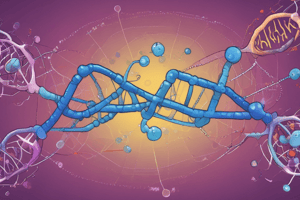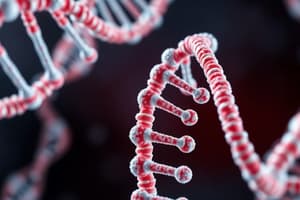Podcast
Questions and Answers
Which of the following terms associated with transcription describe regions of nucleic acid?
Which of the following terms associated with transcription describe regions of nucleic acid?
Place the events in the transcription of a gene in their proper order from left (first event) to right (last event).
Place the events in the transcription of a gene in their proper order from left (first event) to right (last event).
RNA polymerase binds promoter = First event RNA polymerase transcribes gene = Middle event RNA polymerase reaches terminator = Second to last event RNA polymerase exits gene, RNA is released = Last event
In the diagram below, the gray unit represents _____
In the diagram below, the gray unit represents _____
RNA polymerase
In the diagram below, the green unit represents _____
In the diagram below, the green unit represents _____
Signup and view all the answers
In the diagram below, the two blue strands represent _____
In the diagram below, the two blue strands represent _____
Signup and view all the answers
Which of these correctly illustrates the pairing of DNA and RNA nucleotides?
Which of these correctly illustrates the pairing of DNA and RNA nucleotides?
Signup and view all the answers
The direction of synthesis of an RNA transcript is ____.
The direction of synthesis of an RNA transcript is ____.
Signup and view all the answers
What is the corresponding sequence of bases in the RNA that is produced from the DNA sequence given?
What is the corresponding sequence of bases in the RNA that is produced from the DNA sequence given?
Signup and view all the answers
What ultimately determines which DNA strand serves as the template strand?
What ultimately determines which DNA strand serves as the template strand?
Signup and view all the answers
Which three statements correctly describe the processing that takes place before a mature mRNA exits the nucleus?
Which three statements correctly describe the processing that takes place before a mature mRNA exits the nucleus?
Signup and view all the answers
What name is given to the process in which a strand of DNA is used as a template for the manufacture of a strand of pre-mRNA?
What name is given to the process in which a strand of DNA is used as a template for the manufacture of a strand of pre-mRNA?
Signup and view all the answers
What name is given to the process in which the information encoded in a strand of mRNA is used to construct a protein?
What name is given to the process in which the information encoded in a strand of mRNA is used to construct a protein?
Signup and view all the answers
What name is given to the process in which pre-mRNA is edited into mRNA?
What name is given to the process in which pre-mRNA is edited into mRNA?
Signup and view all the answers
Polypeptides are assembled from _____.
Polypeptides are assembled from _____.
Signup and view all the answers
What is the process called that converts the genetic information stored in DNA to an RNA copy?
What is the process called that converts the genetic information stored in DNA to an RNA copy?
Signup and view all the answers
Which of the following does DNA not store information to synthesize?
Which of the following does DNA not store information to synthesize?
Signup and view all the answers
What is a promoter?
What is a promoter?
Signup and view all the answers
What determines which base is to be added to an RNA strand during transcription?
What determines which base is to be added to an RNA strand during transcription?
Signup and view all the answers
Which of the following terms best describes the relationship between the newly synthesized RNA molecule and the DNA template strand?
Which of the following terms best describes the relationship between the newly synthesized RNA molecule and the DNA template strand?
Signup and view all the answers
What happens to RNA polymerase II after it has completed transcription of a gene?
What happens to RNA polymerase II after it has completed transcription of a gene?
Signup and view all the answers
During RNA processing, a(n) _____ is added to the 5' end of the RNA.
During RNA processing, a(n) _____ is added to the 5' end of the RNA.
Signup and view all the answers
During RNA processing, a(n) _____ is added to the 3' end of the RNA.
During RNA processing, a(n) _____ is added to the 3' end of the RNA.
Signup and view all the answers
Spliceosomes are composed of _____.
Spliceosomes are composed of _____.
Signup and view all the answers
The RNA segments joined to one another by spliceosomes are ____.
The RNA segments joined to one another by spliceosomes are ____.
Signup and view all the answers
Translation occurs in the ____.
Translation occurs in the ____.
Signup and view all the answers
Use the table to sort the following ten codons into one of the three bins, according to whether they code for a start codon, an in-sequence amino acid, or a stop codon.
Use the table to sort the following ten codons into one of the three bins, according to whether they code for a start codon, an in-sequence amino acid, or a stop codon.
Signup and view all the answers
What amino acid sequence does the following mRNA nucleotide sequence specify: 5′−AUGGCAAGAAAA−3′?
What amino acid sequence does the following mRNA nucleotide sequence specify: 5′−AUGGCAAGAAAA−3′?
Signup and view all the answers
What amino acid sequence does the following DNA nucleotide sequence specify: 3′−TACAGAACGGTA−5′?
What amino acid sequence does the following DNA nucleotide sequence specify: 3′−TACAGAACGGTA−5′?
Signup and view all the answers
Which of the following mutations would likely be most dangerous to a cell?
Which of the following mutations would likely be most dangerous to a cell?
Signup and view all the answers
What type of mutation could swapping an A for a T cause?
What type of mutation could swapping an A for a T cause?
Signup and view all the answers
Why is a frameshift missense mutation more likely to have a severe effect on phenotype than a nucleotide-pair substitution missense mutation?
Why is a frameshift missense mutation more likely to have a severe effect on phenotype than a nucleotide-pair substitution missense mutation?
Signup and view all the answers
Study Notes
Transcription Basics
- Transcription: The process of synthesizing RNA from a DNA template.
- Key components: Promoter (site where RNA polymerase binds), terminator (signals the end of transcription), gene (the sequence being transcribed).
- Direction of synthesis: RNA is synthesized in the 5' to 3' direction.
Stages of Transcription
-
RNA polymerase activity:
- Binds to the promoter, initiating transcription.
- Transcribes the gene as it moves along the DNA.
- Reaches the terminator, signaling the end of transcription.
- Exits, releasing the RNA molecule.
RNA and DNA Relationship
- RNA is complementary to the DNA template strand, replacing thymine (T) with uracil (U).
- Base pairing in RNA: GTTACG pairs with CAAUGC during transcription.
Eukaryotic RNA Processing
- Pre-mRNA undergoes processing to become mature mRNA:
- Addition of a modified guanine cap at the 5' end.
- Addition of a poly-A tail (50-250 adenine nucleotides) at the 3' end.
- Splicing out of introns by spliceosomes, leaving exons.
Codons and Translation
- Codons: Nucleotide triplets that specify amino acids.
- Start codon: AUG (methionine), initiation of translation.
- Stop codons: UAA, UAG, UGA, terminate translation.
- Example amino acid sequences correspond to mRNA sequences:
- 5′-AUGGCAAGAAAA-3′ translates to Met-Ala-Arg-Lys.
Mutation Types
-
Point mutations can lead to:
- Silent mutations: No change in amino acid sequence.
- Missense mutations: Result in a different amino acid.
- Nonsense mutations: Introduce a premature stop codon.
- Frameshift mutations: Caused by insertions or deletions that disrupt the reading frame.
Protein Structure
-
Levels of protein structure:
- Primary: Amino acid sequence.
- Secondary: Alpha helices and beta pleated sheets from hydrogen bonding.
- Tertiary: Overall shape due to interactions between R groups.
- Quaternary: Aggregation of multiple polypeptide chains.
Role of RNA Types
- mRNA: Carries genetic information from DNA to ribosome.
- tRNA: Brings amino acids to the ribosome during translation; contains an anticodon for pairing with mRNA.
- rRNA: Major component of ribosomes, aiding in translation.
Cellular Location of Protein Synthesis
- Translation takes place in the cytoplasm.
- Eukaryotic protein synthesis: Begins in the ribosome after processing mRNA in the nucleus.
Genetic Code Characteristics
- Genetic code consists of codons which dictate amino acid sequence.
- Different codon combinations yield different amino acids, with redundancy in the genetic code.
Disease Association
- Mutations in the CFTR gene lead to cystic fibrosis, with various mutations (like delta F508) affecting protein function.
Risk of Mutations
- Deletion of a single nucleotide is often most detrimental due to potential frameshifts.
Studying That Suits You
Use AI to generate personalized quizzes and flashcards to suit your learning preferences.
Description
Test your understanding of transcription with these flashcards from Chapter 17 of Mastering Biology. Learn key terms associated with nucleic acids and the order of events during gene transcription. Perfect for reinforcing your comprehension of essential biological processes.




